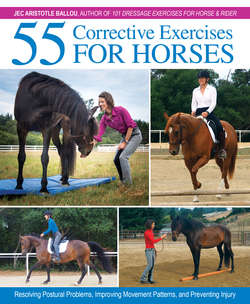Читать книгу 55 Corrective Exercises for Horses - Jec Aristotle Ballou - Страница 11
На сайте Литреса книга снята с продажи.
Why We Need Corrective Exercises
ОглавлениеSkilled riding is often all it takes to improve a horse’s athleticism, performance, and overall well-being. But just as often, even good dressage-based training programs fail to fully root out the habits and patterns that prevent many horses from reaching optimal movement and correctness of their gaits. Anything from a poorly fitting saddle to inconsistent exercise schedules to an injury or stress, or past postural imbalances can create compromises. These quickly become deeper impediments to a horse’s movement mechanics that persist even with good, regular riding schedules.
The body’s way of taking care of itself during physical imbalances is to put up defenses. These defenses take the form of muscular spasms, adhesions, tightened muscles, restricted joint motions, and signals to and from the central nervous system to move differently.
Curing these defenses is not as simple as giving the horse a period of rest, though that can seem like a sensible solution. Adhesions and spasms, for instance, do not go away on their own after aggravating sources have been eliminated. They require outside manipulation as well as correct signals from the body to clear out. Putting a horse out in the field for a few months with the hope that everything will clear up rarely fixes the underlying problems.
Therapies like chiropractic care and massage are generally successful in releasing areas of immobility so the horse is able to move optimally. They free up areas of tension and compromised mobility that the body will not release by itself. However, they only set the stage; they do not by themselves create healthy movement. For that, the horse must be taken through exercises that habituate correct new patterns (fig. 1.1). Physical motions are governed by an underlying wiring that will still store faulty signals until these signals are reprogrammed.
1.1: The state of an athlete’s body is always forming patterns that influence its mechanics. Little issues or imbalances frequently become larger ones when a pattern takes root. Training programs must make use of exercises that instill good patterns, while also strengthening the signals that control them.
This is where corrective exercises like the ones in this book come in.
